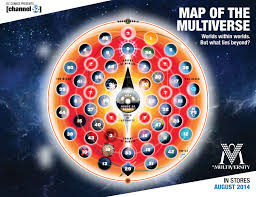
Lanza’a expertise in regenerative medicine and cloning was brought to fusion with quantum mechanics… such a calling has fallen upon many an unsuspecting human over the course of recent years. The conclusion that consciousness is the foundation of the universe, that effectively the universe is alive, seems inevitably to be reached when blending quantum mechanics with anything remotely bio- or socio- logical. It seems that you can take the humanity out of physics, but you can’t take physics out of humanity. As the only species on the planet to be actively engaging in explorations of the Universe, it’s safe to say that humans are the apex of its self-searching exercise, on this planet at least.
The scientist’s analogy with regards to our relationship with spacetime is quaint, in terms of turtles with shells, his point being that we carry spacetime around with us like a permanent appendage, and that we still exist whatever the spacetime conditions may be in which we are existing. In this way he supports the concept of life after death, or rather, the potential infinity of existence, since consciousness is interdependent of spacetime and is non-local in character. Lanza also brings into play the role of the Multiverse, a principle developed by Hugh Everett in the 1950s and hotly contested by the younger batch of quantum mechanics in the latter half of the century. The idea is that multiple universes exist in a constant state of self-creation - at any given moment the universe divides into other instances of itself, to split again at the next moment, each of these moments being ignited, if you like, by a decision making process. Taken literally, every time you make a decision the universe splits to allow for the decision you have made and any other version of other decisions that could have been made. My take on this is that every time we choose to do something, we move into the Multiverse where that cause-and-effect track resides, but just as in the branching mechanism described above, there is no sensation of the transition because the entire infinite structure is all part and parcel of the same thing. Equally, there is no certainty that the track we find ourselves on – or the Multiverse version we find ourselves in – will not loop itself back to the original ‘intended’ track at some future point, hence aligning itself with the choice-destiny paradox we will be arguing till the end of time.

Near-death experiences are bringing matters to light on a grand scale, delivering information to researchers which seems to point inevitably towards the inevitability of an afterlife. This in itself is bringing about an ever-widening acceptance of there being an afterlife in the first place, and in time the mechanics of Afterlife will no doubt be postulated and argued about as vociferously as the Copenhagen Interpretation was during the first half of the 20th century. Personally, my quest for quantum information began 20 years ago and now, I’m happy to find, new discoveries are inspiring hunter-gatherers on the quantum quest to harvest enormous gems of great importance… finally, after a decade or more of relative inactivity. In the afterglow of their trail, more information is coming to light for general assimilation, and the word Quantum is now a household commodity rather than an indication of borderline insanity. While I’m glad to see it, I’m still a little annoyed that Brian Cox, who pompously pontificated as a self-styled Positivist when he first set out on the train to fame, is going to be seamlessly forgiven when he comes round to accepting that the Uncertainty Principle is not just a doorway, but the entire framework on which the multiple variants of consciousness, choice and universal continuum have ever stood, and will ever stand for evermore.
 RSS Feed
RSS Feed
